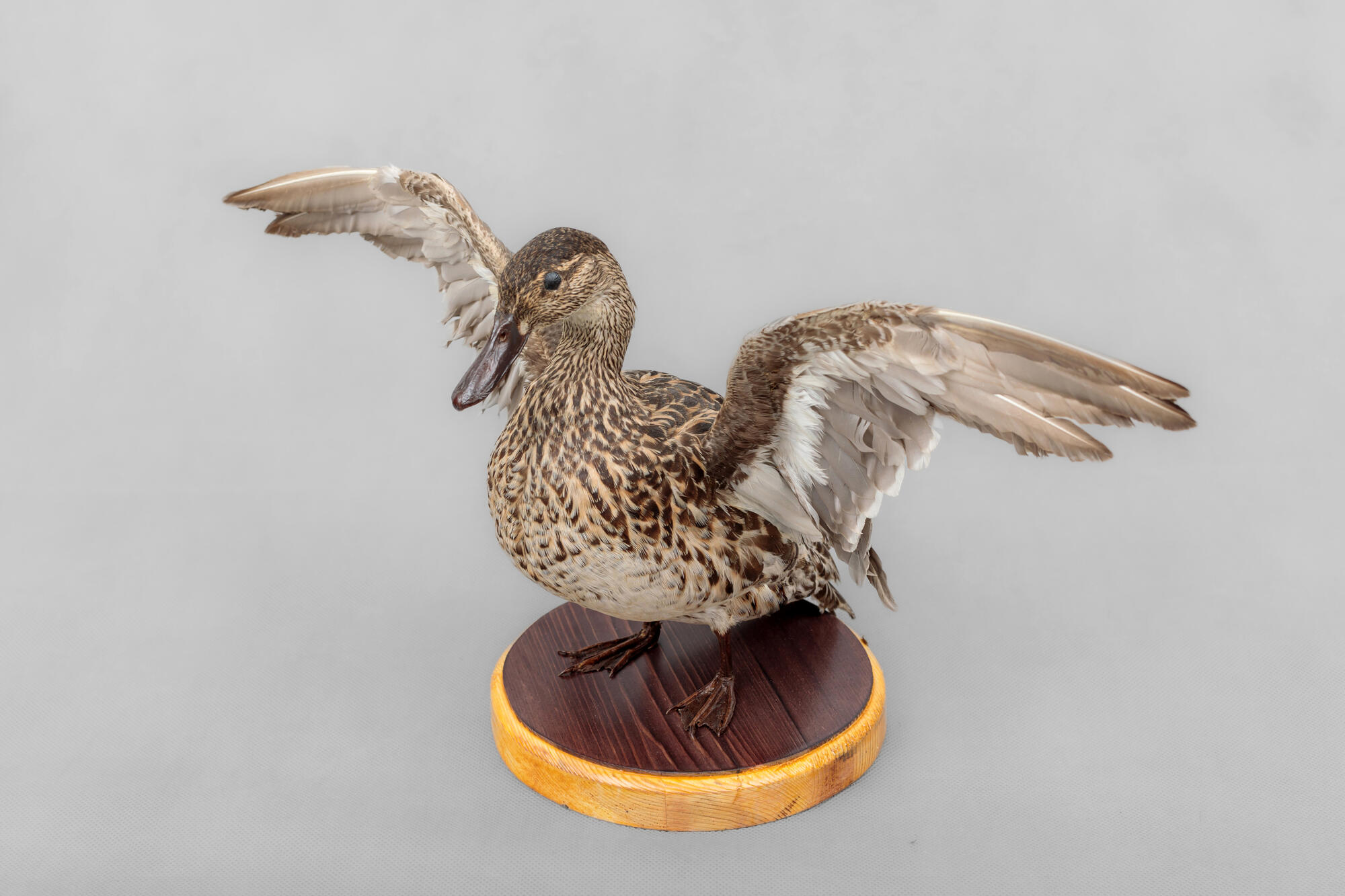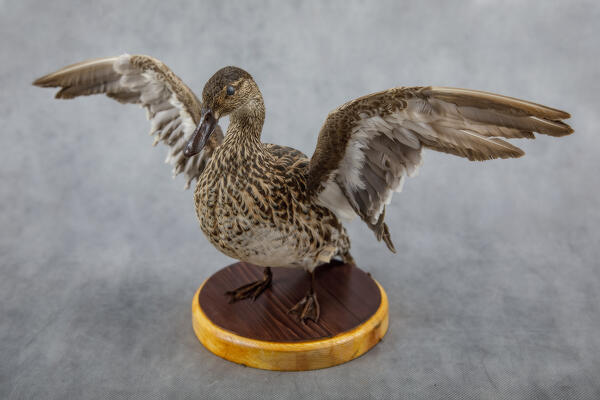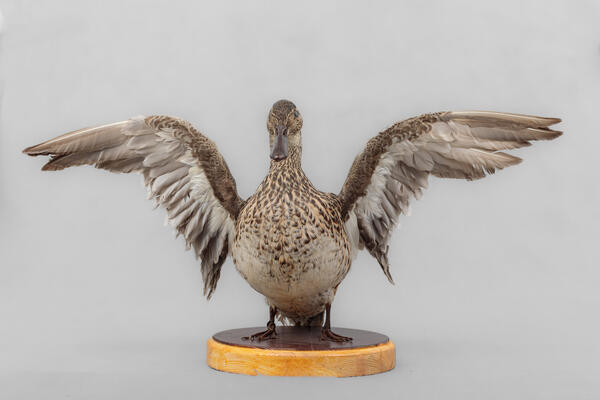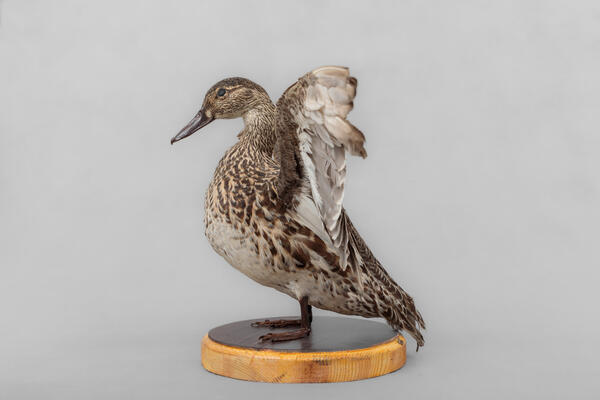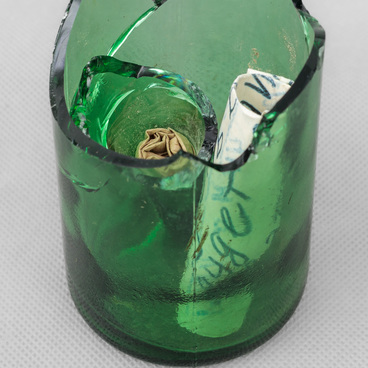This northern shoveler taxidermy mount is housed in the Uray City Historical Museum. The bird is a species of waterfowl belonging to the Anatidae family. This northern shoveler is unmistakable due to its unique large spatulate bill.
The bill widens toward the tip and looks disproportionate, resembling a flipper. It is equipped with a row of bristles it uses to filter food from the water. This is a medium-sized duck: its mass ranges from 400 grams to one kilogram.
The northern shoveler has a small head, so the bill looks even bigger. The neck is short. There are color differences between sexes. Adult males look especially bright before the breeding season, when they get iridescent dark blue and green hues on the head, neck and above the tail.
Northern shovelers prefer to live next to other birds, especially gulls. When the predator is discovered, gulls make a lot of noise and alarm the rather sluggish ducks. In flight, northern shovelers hold their heads down. The birds may nest in pairs or small flocks. They can be described as silent, rather wary, and even secretive birds.
Northern shovelers tend to forage on water bodies and feed on pondweed they collect from the bottom. Sometimes these birds go fully underwater with only their tail visible above the surface. In this way, they create whirlpools, so that plants, larvae of various insects, crustaceans and mollusks rise closer to the surface.
Northern shovelers mainly inhabit open freshwater bodies; however, they may also prefer a forest zone in search of shallow wetlands. The birds will always choose areas with abundant vegetation. Having located a nest site, the female starts construction: she makes a small hole about 15 centimeters deep and lines it with leaves and grass. Then she covers everything with her own down, which she plucks from her chest. Northern shovelers lay a little more than 10 eggs per clutch. The eggs are incubated for about three weeks.
The majority of nesting failure results from predation by red foxes, martens and otters. Other offenders include hawks, eagles, and ravens. Northern shovelers migrate to the Black Sea, as well as to the Mediterranean countries.
The bill widens toward the tip and looks disproportionate, resembling a flipper. It is equipped with a row of bristles it uses to filter food from the water. This is a medium-sized duck: its mass ranges from 400 grams to one kilogram.
The northern shoveler has a small head, so the bill looks even bigger. The neck is short. There are color differences between sexes. Adult males look especially bright before the breeding season, when they get iridescent dark blue and green hues on the head, neck and above the tail.
Northern shovelers prefer to live next to other birds, especially gulls. When the predator is discovered, gulls make a lot of noise and alarm the rather sluggish ducks. In flight, northern shovelers hold their heads down. The birds may nest in pairs or small flocks. They can be described as silent, rather wary, and even secretive birds.
Northern shovelers tend to forage on water bodies and feed on pondweed they collect from the bottom. Sometimes these birds go fully underwater with only their tail visible above the surface. In this way, they create whirlpools, so that plants, larvae of various insects, crustaceans and mollusks rise closer to the surface.
Northern shovelers mainly inhabit open freshwater bodies; however, they may also prefer a forest zone in search of shallow wetlands. The birds will always choose areas with abundant vegetation. Having located a nest site, the female starts construction: she makes a small hole about 15 centimeters deep and lines it with leaves and grass. Then she covers everything with her own down, which she plucks from her chest. Northern shovelers lay a little more than 10 eggs per clutch. The eggs are incubated for about three weeks.
The majority of nesting failure results from predation by red foxes, martens and otters. Other offenders include hawks, eagles, and ravens. Northern shovelers migrate to the Black Sea, as well as to the Mediterranean countries.
